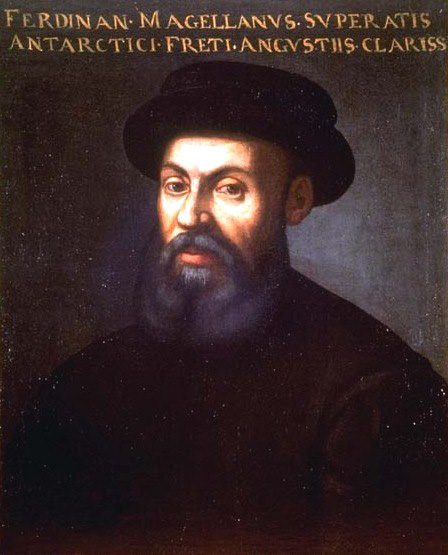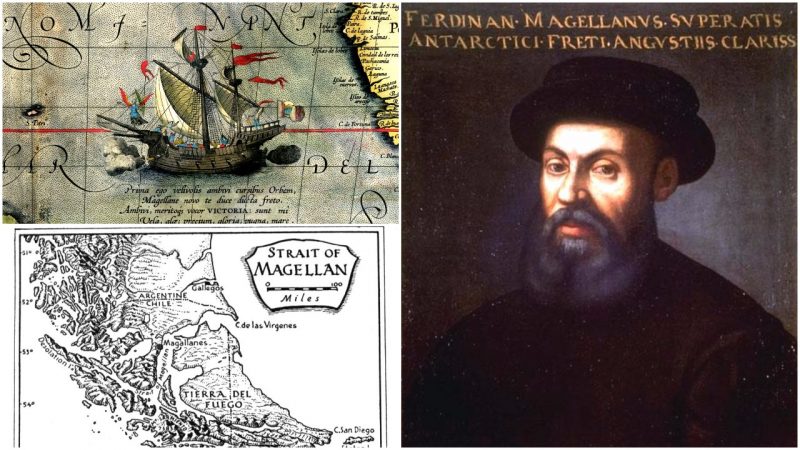We all recall Ferdinand Magellan from our history or geography classes.
He was the famous Portuguese explorer who led the Spanish expedition to the East Indies from 1519–22, which turned out to be the very first circumnavigation of the Earth.
Magellan was killed during his historic journey, which was then completed by the Spanish explorer Juan Sebastián Elcano. The odyssey lasted for three very long years and took hundreds of lives in addition to Magellan’s. It also changed Europe’s comprehension of world geography.
There are many fascinating stories about this expedition. It was financed by the Spanish, and the crew consisted mostly of Spanish and Portuguese men. However, the diverse group featured people from Greece, England, France, Germany, and North Africa as well.
 An anonymous portrait of Ferdinand Magellan, 16th or 17th century.
An anonymous portrait of Ferdinand Magellan, 16th or 17th century.The primary purpose of the expedition was not to circumnavigate the globe but to find a western route to the Moluccas, an archipelago in Indonesia which was abundant in spices. The journey was partly inspired by Christopher Columbus’s voyages to the West (1492–1503), which had a similar goal of reaching the Indies and striking trade deals between Spain and the Asian kingdoms. As we all know, the Spaniards discovered the Americas and realized that what they’d encountered was an entirely new continent, much distant from Asia.
In 1494, Pope Alexander VI signed the Treaty of Tordesillas, which divided the newly-discovered world in half between Spain and Portugal. According to the treaty, the more efficient eastern route to the Spice Island was put under Portuguese control, while the Spanish needed to find a new passage by sailing west around South America.
 Effigy of Ferdinand Magellan in the Monument to the Discoveries, in Lisbon, Portugal, photo credit
Effigy of Ferdinand Magellan in the Monument to the Discoveries, in Lisbon, Portugal, photo creditWhile Magellan was Portuguese by origin, it was King Charles I of Spain who commissioned his new expedition. King Manuel I of Portugal saw this as an act of insult, and he did everything in his power to disrupt Magellan’s arrangements for the voyage. The Portuguese king allegedly ordered that Magellan’s properties be vandalized and may have even requested the assassination of the famous navigator. Magellan eventually sailed to the open seas in August 1519, and even then, a Portuguese fleet of caravels was sent after him to capture and chain him.
Magellan’s entire voyage was eventful. First, there were the internal clashes aboard his vessels. The Spanish part of the crew detested the idea that their leader was from Portugal, so problems piled up quickly. The crews launched several mutinies before the fleet reached South America.
 The Nao Victoria Replica in the Nao Victoria Museum, Punta Arenas, Chile. photo credit
The Nao Victoria Replica in the Nao Victoria Museum, Punta Arenas, Chile. photo creditThe most serious mutiny occurred in April 1520, when three of the five ships in Magellan’s fleet turned against their captain. Magellan and his followers managed to handle the situation, abandoning two men on an island when they were found to be planning another mutiny. The rebellions persisted, and by the end of that year, one ship called the San Antonio had deserted the fleet, returning to Spain.
 Monument of Ferdinand Magellan in Punta Arenas in Chile. The statue looks toward the Strait of Magellan. photo credit
Monument of Ferdinand Magellan in Punta Arenas in Chile. The statue looks toward the Strait of Magellan. photo creditOne more ship was lost when the fleet faced terrible storms near the southern tip of South America. The journey continued, though, and in November 1520, Magellan reached what is today known as the Strait of Magellan. The famous navigator also gave the Pacific Ocean its name, thankful for its calm and gentle waters. He called it “Mar Pacifico,” which is Portuguese for “peaceful sea.”
Magellan assumed that he would quickly reach the Spice Islands, not knowing that the Pacific is the largest body of water on Earth. The vessels spent an exhausting 98 days at open sea before seeing land.
 The Strait of Magellan cuts through the southern tip of South America, connecting the Atlantic and Pacific oceans.
The Strait of Magellan cuts through the southern tip of South America, connecting the Atlantic and Pacific oceans.While anchored near what today is Argentina, Magellan’s crew reportedly met 8-foot-tall men on the shores of Patagonia. One of the “giants” joined the fleet and was later baptized and renamed Paul, but he died while crossing the Pacific. This episode of Magellan’s odyssey it still puzzling to historians. They theorize that Magellan’s giants must have been natives of southern Argentina and Chile, likely of the Tehuelche tribe. Magellan’s people probably exaggerated the height of these indigenous people, but the entire encounter established the myth of the Patagonian giants.
Another little-known fact is that Magellan, a faithful Christian evangelist, converted many indigenous people (aside from “Paul”) to Christianity. Probably the most famous example of this was Magellan’s arrival in the Philippines. There, he baptized King Humabon of the Cebu and many of his people.
 Monument in Lapu-Lapu City, Cebu in the Philippines. photo credit
Monument in Lapu-Lapu City, Cebu in the Philippines. photo creditOn the island of Mactan in the Philippines, Magellan entered a battle with the locals after the king named Lapu-Lapu refused to convert to Christianity. Magellan was brutally killed in the conflict, and to the people of Mactan, he was remembered as a tyrant.
From this point on, command of the Spanish fleet was taken over by Elcano, who managed to return to Spain in September 1522. Just one vessel, called Victoria, survived the voyage. Only 18 members of the party remained from the crew that numbered 270 people when it set off on in 1519. No European attempted to repeat the circumnavigation of the planet for nearly six full decades after that.
 Victoria, the only ship of Magellan’s fleet to complete the circumnavigation. Detail from a map by Ortelius, 1590.
Victoria, the only ship of Magellan’s fleet to complete the circumnavigation. Detail from a map by Ortelius, 1590.Magellan had already reached Southeast Asia on previous voyages traveling east. By returning to this area once again, now approaching from the west, the Portuguese navigator accomplished a nearly complete personal circumnavigation of the globe.
Read another story from us: Science fiction author Arthur C. Clarke...
Last but not least, there was one very significant member of Magellan’s crew: his personal slave, Enrique. He had been Magellan’s slave for at least eight years before commencing the 1519 expedition. A native of the East Indies, accounts suggest that Enrique probably spoke the Malay dialect. According to “History,” if Enrique really was born in the East Indies, he would have already circled the Earth by the time Magellan reached the Philippines. So, it may have been a slave — not Magellan or any other European sailor — who was the first person to circumnavigate the Earth.














Pentru a putea adăuga comentarii trebuie să fii membru al altmarius !
Alătură-te reţelei altmarius